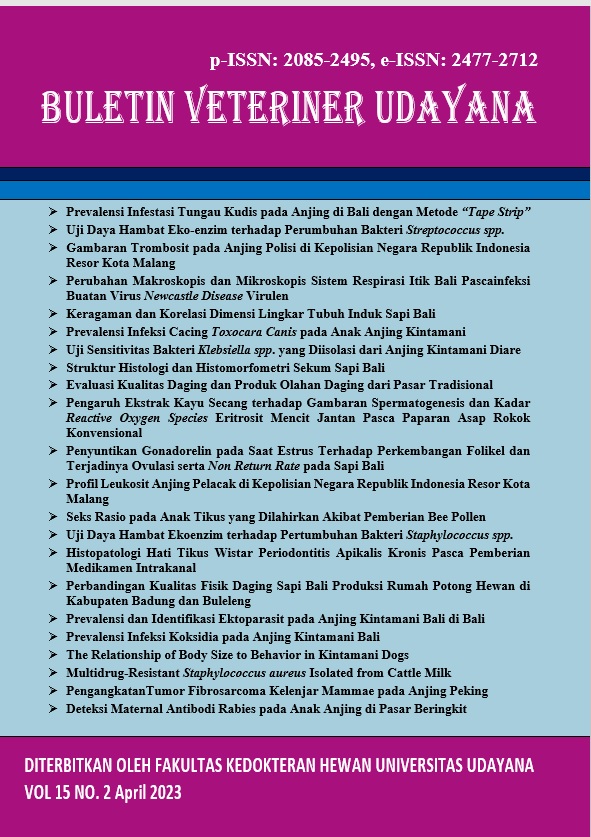RELATIONSHIP OF BODY SIZE TO BEHAVIOR IN KINTAMANI DOGS
Abstract
The Balinese believe that body size (the ratio of body length to snout length) in dogs is related to behavior, therefore body size is used to predict dog character. How to predict by measuring body size is a local wisdom that is still trusted for choosing a good dog. This belief has been running for a long time from their ancestors and has become a culture. Dog behavior according to local wisdom in Bali in general and in Sukawana Village, Kintamani District, Bangli Regency in particular, is categorized as: guna, jaya, forced, tek and kyul. Guna is a dog with an obedient character, useful and suitable as a hunting dog. Jaya is a dog with good character, attractive, energetic, tends to be hyperactive, this type of dog is also good for hunting. Force is a dog that is difficult to manage, requiring special handling, suitable for keeping the house. Tek is a dog with dirty behavior and difficult to train or manage and Kyul is a dog with a lazy character. A total of 66 Kintamani dogs were used as experimental animals. The research design used a cross-sectional study design. Body size observation data was then compared with clinical observations in the same dog. The results show that there is a relationship between behavior and body size (ratio of body length to snout length). It was concluded that body size (body length to snout length ratio) can be implemented to predict behavior.
Downloads
References
Cannas S, Talamonti Z, Mazzola S, Minero M, Picciolini A, Palestrini C. 2018. Factors Associated with Dog Behavioral Problems Referred to a Behavior Clinic. J. Vet. Behav. 24: 42–47.
Carcan A. 2017. Katalog Buku Salinan Lontar. Perpustakaan Kedong Kertya. No. 392.IIIc. Singaraja.
Dharmawan IN. 2009. Anjing Bali dan Rabies. Cetakan Pertama. Penerbit: Buku Arti. Arti Foundation. Denpasar, Bali.
Helton WS and Helton ND. 2010. Physical Size Matters in The Domestic Dog’s (Canis lupus familiaris) Ability to Use Human Pointing Cues. Behav. Processes. 85(1): 77-79.
Jensen P. 2007. Behavioural Biology of Dogs. Publisher: CABI ProQuest. Ebook Central. Penerbit Cromwell Pres. http://ebookcentral.proquest.com/lib/unud-ebooks/detail.action?doc Created from unud-ebooks on 2018-02-28 19:11:44.
Leaver SDA and Reimchen TE. 2008. Behavioural responses of canis familiaris to different tail lengths of a remotely-controlled life-size dog replica. Behav. 145: 377-390.
Lehner. 1998. Handbook of Ethological Methods. eBook. Cambridge University Press.
Lindsay S. 2005. Handbook of Applied Dog Behavior and Training Procedures and Protocols. Blackwell, Oxford.
Martin P. and Bateson P. 1986. Measuring Behaviour. Cambridge University Press, Cambridge.
McGreevy PD, Georgevsky D, Carrasco J, Valenzuela M, Duffy DL, Serpell JA. 2013. Dog behavior co-varies with height, bodyweight and skull shape. PLoS ONE. 8(12): e80529.
Mehrkama LR and Wynnea CDL. 2014. Behavioral differences among breeds of domestic dogs (Canis Lupus Familiaris): Current status of the science. Appl. Anim. Behav. Sci. 155: 12-27.
Miklosi A. 2007. Dog, Behaviour, Evolution, and Cognition. Oxford University Press, Inc. New York.
Podberscek AL and Serpell JA. 1997. Environmental influences on the expression of aggressive behaviourin English cocker spaniels. Appl. Anim. Behav. Sci. 52: 215-227.
Snedecor GW and Cochron WG. (1994). Statistical Methods. 8th ed. Oxford and IBH Publising Co. Calcuta, India.
Tami A, Diverio S, Barone A. 2008. Relationship between management factors and dog behavior in a sample of Argentine dogos in Italy. J. Vet. Behav. Clin. Appl. Res. 3(2): 59-73.





